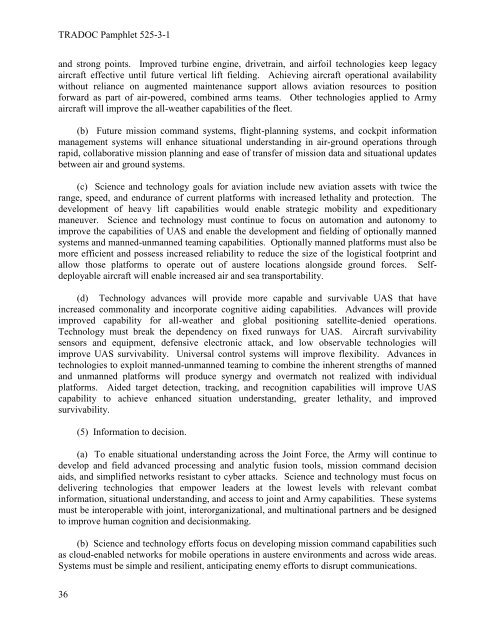TP525-3-1
TP525-3-1
TP525-3-1
You also want an ePaper? Increase the reach of your titles
YUMPU automatically turns print PDFs into web optimized ePapers that Google loves.
TRADOC Pamphlet 525-3-1<br />
and strong points. Improved turbine engine, drivetrain, and airfoil technologies keep legacy<br />
aircraft effective until future vertical lift fielding. Achieving aircraft operational availability<br />
without reliance on augmented maintenance support allows aviation resources to position<br />
forward as part of air-powered, combined arms teams. Other technologies applied to Army<br />
aircraft will improve the all-weather capabilities of the fleet.<br />
(b) Future mission command systems, flight-planning systems, and cockpit information<br />
management systems will enhance situational understanding in air-ground operations through<br />
rapid, collaborative mission planning and ease of transfer of mission data and situational updates<br />
between air and ground systems.<br />
(c) Science and technology goals for aviation include new aviation assets with twice the<br />
range, speed, and endurance of current platforms with increased lethality and protection. The<br />
development of heavy lift capabilities would enable strategic mobility and expeditionary<br />
maneuver. Science and technology must continue to focus on automation and autonomy to<br />
improve the capabilities of UAS and enable the development and fielding of optionally manned<br />
systems and manned-unmanned teaming capabilities. Optionally manned platforms must also be<br />
more efficient and possess increased reliability to reduce the size of the logistical footprint and<br />
allow those platforms to operate out of austere locations alongside ground forces. Selfdeployable<br />
aircraft will enable increased air and sea transportability.<br />
(d) Technology advances will provide more capable and survivable UAS that have<br />
increased commonality and incorporate cognitive aiding capabilities. Advances will provide<br />
improved capability for all-weather and global positioning satellite-denied operations.<br />
Technology must break the dependency on fixed runways for UAS. Aircraft survivability<br />
sensors and equipment, defensive electronic attack, and low observable technologies will<br />
improve UAS survivability. Universal control systems will improve flexibility. Advances in<br />
technologies to exploit manned-unmanned teaming to combine the inherent strengths of manned<br />
and unmanned platforms will produce synergy and overmatch not realized with individual<br />
platforms. Aided target detection, tracking, and recognition capabilities will improve UAS<br />
capability to achieve enhanced situation understanding, greater lethality, and improved<br />
survivability.<br />
(5) Information to decision.<br />
(a) To enable situational understanding across the Joint Force, the Army will continue to<br />
develop and field advanced processing and analytic fusion tools, mission command decision<br />
aids, and simplified networks resistant to cyber attacks. Science and technology must focus on<br />
delivering technologies that empower leaders at the lowest levels with relevant combat<br />
information, situational understanding, and access to joint and Army capabilities. These systems<br />
must be interoperable with joint, interorganizational, and multinational partners and be designed<br />
to improve human cognition and decisionmaking.<br />
(b) Science and technology efforts focus on developing mission command capabilities such<br />
as cloud-enabled networks for mobile operations in austere environments and across wide areas.<br />
Systems must be simple and resilient, anticipating enemy efforts to disrupt communications.<br />
36


